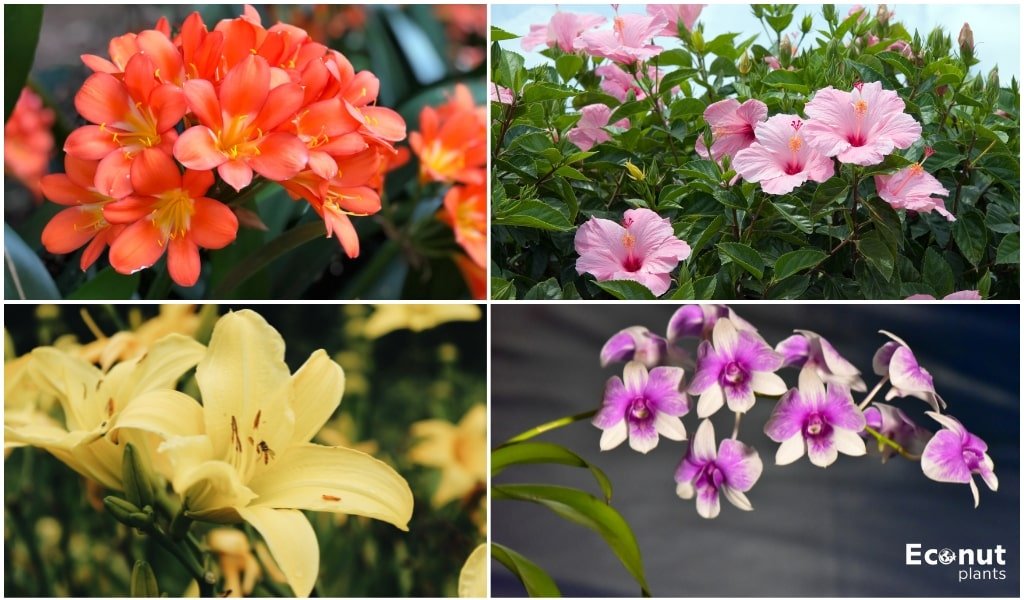Imagine being surrounded by a lush tropical setting while enjoying the comforts of your own home. The calming tones of green captivate your eyes every time you peek out the kitchen window. Of course, you can still have the most exquisite flowering plants in a tropical garden even if you do this.
A few of the blooming plants that will improve the look of your indoor tropical garden are these. Provides her top picks for tropical flowering plants that are great for the yard or house.
1. Begonia
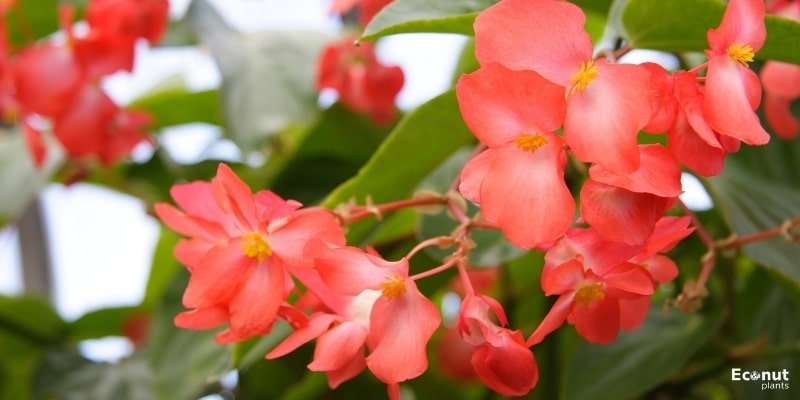 Botanical Name: Begonia
Botanical Name: Begonia
Sun Exposure: Full Sun to Partial Shade
Hardiness Zone: 7-11
My favourite plants are begonias since they look great both indoors and outdoors. Asia, Africa, and Central and South America are the native regions of begonias.
Grown easily, begonias have a similar texture and behaviour to succulents. They thrive with little water and sunlight, and their thick, waxy leaves are a characteristic. The blossoms can be orange or yellow, but they are usually pink, red, and white in hue. They can have either one or two petals.
2. Bougainvillea
 Botanical Name: Bougainvillea
Botanical Name: Bougainvillea
Sun Exposure: Full Sun
Hardiness Zone: 9-11
In many tropical and subtropical areas around the world, this native of South America has found a home in gardens. Both shrubby and vining varieties are possible, and it usually prefers a climbing structure.
Generally speaking, the leaf is delicate and light to medium green in comparison to other plant parts. Don’t put this where someone might stumble upon it because the stems are prickly and coated in big, sharp thorns.
The plant’s vibrant sections are bracts that encircle tiny, white, tubular blooms. These bracts come in bicolour, coral, purple, pink, red, and white varieties. Helen Johnson, with its gorgeous bright pink colour, is my favourite.
3. Calla Lily
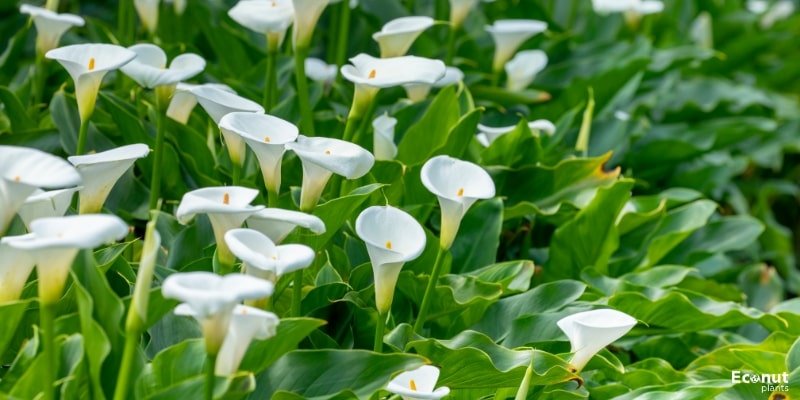 Botanical Name: Zantedeschia
Botanical Name: Zantedeschia
Sun Exposure: Full Sun to partial shade
Hardiness Zone: 8-13
One of the most often used flowers for bridal bouquets and cut arrangements is calla lilies. Long-lasting, cut flowers with a diversity of striking colours are their distinctively gorgeous blossoms. Their aggressive growth behaviour has made them quite invasive in many warm-weather locales, despite being native to Africa.
Although calla lilies love hot, humid conditions, you should plant them in an area that receives morning light and afternoon shade if you live in a very hot region. Even in warm climates, they will die back in the winter and reappear in the spring. They prefer moist but well-drained soil. They can be cultivated as an annual in colder regions.
4. Chenille Plant
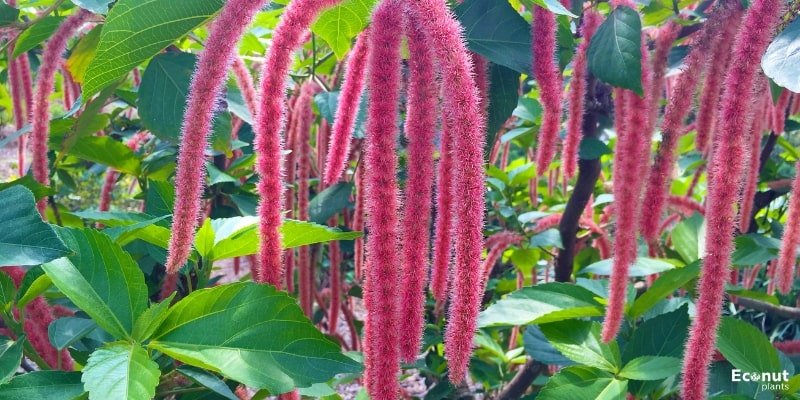 Botanical Name: Acalypha hispida
Botanical Name: Acalypha hispida
Sun Exposure: Full Sun to partial shade
Hardiness Zone: 10-11
It makes sense that the French term for the caterpillar is where the chenille plant got its scientific name. From the leafy green stalks, the crimson blossoms resemble large, wiggling caterpillars. Related to crotons and poinsettias, this plant provides a wonderful cut flower that gives a floral arrangement a lot of texture and character.
The chenille plant is a shrub that grows to a maximum height of 15 feet in tropical conditions, although it typically reaches only 5 or 6 feet.
It is quite easy to grow in containers outside of tropical climate zones, and because the flowers fall almost to the ground, it makes a beautiful hanging plant. It is evergreen and can bloom year-round under the right circumstances, but it must be brought indoors during cold weather.
5. Kahili Ginger
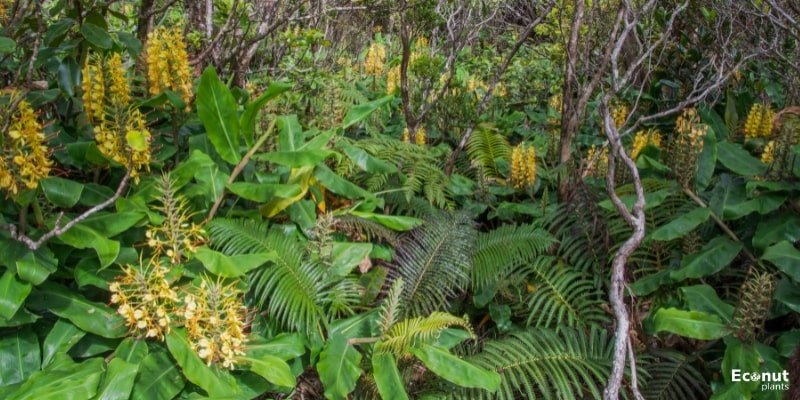 Botanical Name: Hedychium gardnerianum
Botanical Name: Hedychium gardnerianum
Sun Exposure: Full Sun to partial shade
Hardiness Zone: 8-11
Among the most vivid in the group is this intriguing kind of ginger. This flowering, rhizomatic perennial prefers some afternoon shade but can tolerate full sun for most of the day. It also prefers rich soil and a lot of rainfall.
Kahili ginger is native to India. It has beautiful, tropical flora. Robust, lance-shaped leaves with a grey-green hue. In late summer, the plant creates an inflorescence that is on par with any other plant in the garden. Tall clusters of exotic golden blooms are a superb focal point, especially when combined with their delightfully warm smell.
6. Passionflower
 Botanical Name: Passiflora incarnata
Botanical Name: Passiflora incarnata
Sun Exposure: Full Sun to partial shade
Hardiness Zone: 6-11
The passionflower is a fantastic tropical flowering vine. In milder climes, the plant will reappear in the spring after freezing and then die back to the ground. Due to its evergreen habit, the vine naturally grows significantly larger in warmer climates.
This vine has incredibly beautiful and unusual blossoms. Five equal-sized and shaped sepals and five petals form the flower’s outer ring.
The most fascinating portion of the flower is located just within this area: the corona filaments, which are composed of many thread-like structures. A genuinely distinctive bloom, the center of the bloom has five stamens and an ovary capped with three styles that terminate in huge heads.
7. Peace Lily
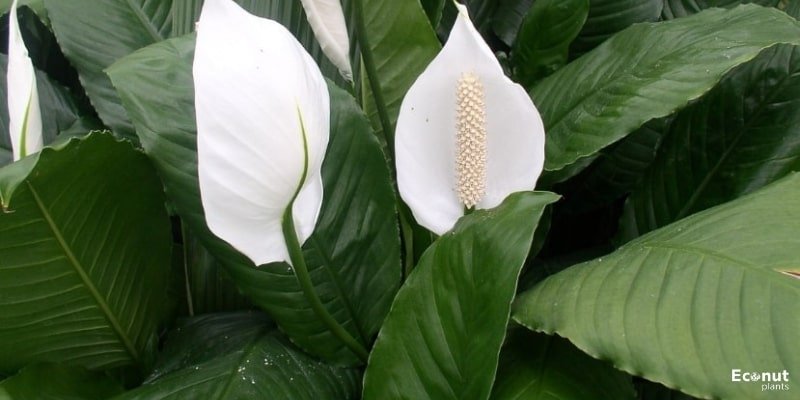 Botanical Name: Spathiphyllum spp.
Botanical Name: Spathiphyllum spp.
Sun Exposure: Full Sun to partial shade
Hardiness Zone: 11-12
The peace lily, a common houseplant that thrives in outside conditions, is a tropical plant. A contented peace lily requires consistency. These plants like consistent warmth and temperature. Their favourite position indoors will be beside a sunny window that is partially sheltered from the sun. They like being frequently irrigated and relatively root-bound.
The peace lily’s stiff, glossy leaves have the appearance of enormous bananas. The flower progressively unfolds to expose beautiful solitary spathes or petals with a prominent spadix.
8. Rock trumpet
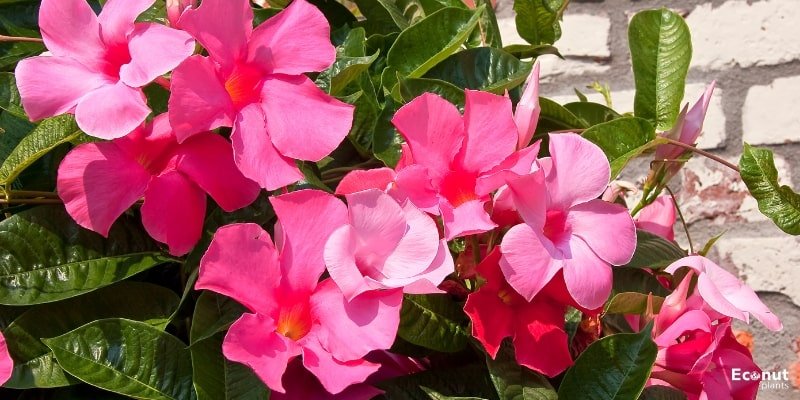 Botanical Name: Mandevilla
Botanical Name: Mandevilla
Sun Exposure: Full Sun
Hardiness Zone: 9-11
This tropical-blooming vine is very popular, quite easy to cultivate, and very eye-catching in the yard. Native to the Americas, rock trumpet, often referred to as Mandevilla, is typically planted as an annual in colder climates but can become evergreen in tropical ones. Additionally, if the weather is warm enough, it can bloom almost year-round.
Growing fast, rock trumpet blooms from late April until the temperature falls below fifty degrees. The trumpet-shaped, colourful flowers have yellow throats sometimes and come in pink, white, and red hues. They are quite striking. As a bonus, the blossoms are aromatic. All around, these are fan favourites.
9. Scarlet Sage
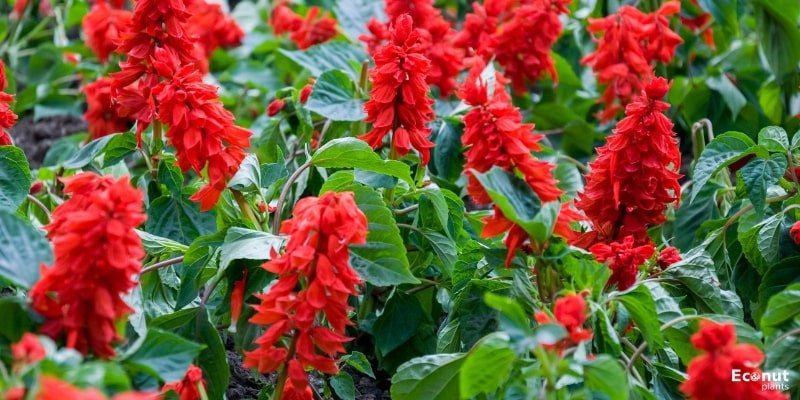 Botanical Name: Salvia splendens
Botanical Name: Salvia splendens
Sun Exposure: Full Sun
Hardiness Zone: 10-11
Native to Brazil, scarlet sage is usually planted as a fragile perennial, though zones 10–11 will keep it evergreen. Salvia plants are a great choice for a striking splash of colour. They bloom so profusely that they are hard to beat as the top blooming in any garden.
With a maximum height of only one to two feet, scarlet sage is a low-growing form of salvia. It features toothy-looking, eye-catching green foliage. Red flower spikes that are tall and persist until the first frost develops in late spring. This has excellent disease and pest resistance and is another favourite of hummingbirds.
10. Tropical Hibiscus
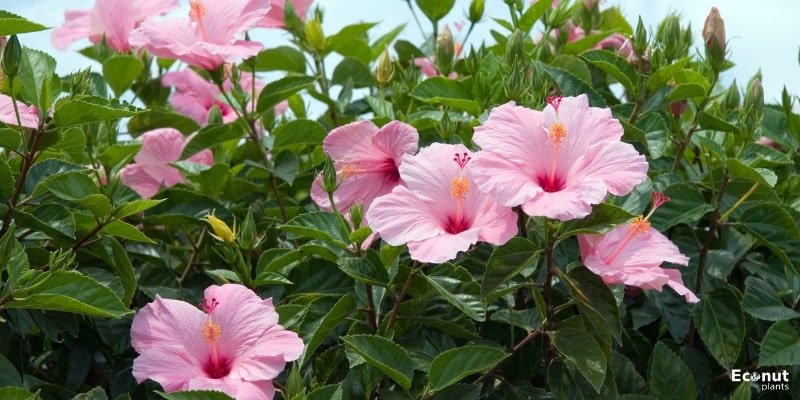 Botanical Name: Salvia splendens
Botanical Name: Salvia splendens
Sun Exposure: Full Sun
Hardiness Zone: 9-11
The shoeblack plant is another name for the tropical hibiscus (Hibiscus rosa-sinensis). Although it is frequently grown as a container plant worldwide and is extensively cultivated in the tropics and subtropics, it is endemic to Vanuatu.
This evergreen flower is best when planted in rich, well-draining soil with full light. Because hibiscus plants are heavy feeders, it is challenging to over-fertilize them. Some cultivars yield blossoms as big as dinner plates. Though some are purple and pink, the majority of the blossoms are red, orange, and yellow in hue.
11. Shampoo Ginger
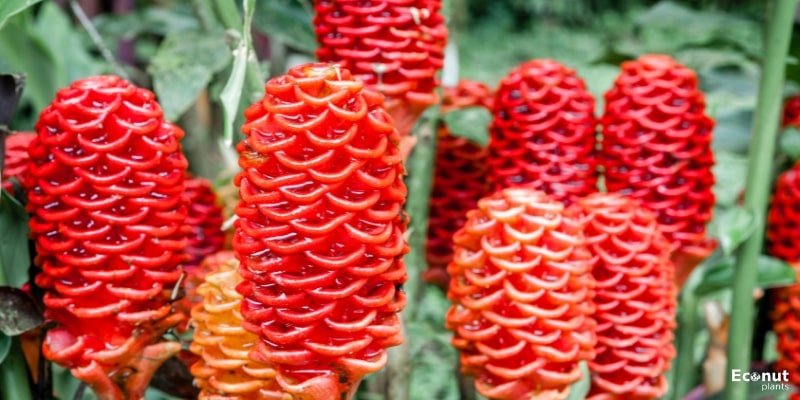 Botanical Name: Zingiber zerumbet
Botanical Name: Zingiber zerumbet
Sun Exposure: Full Sun to partial shade
Hardiness Zone: 8-12
This variety of ginger is especially intriguing and is a staple in tropical gardens. Ginger is a plant whose sap has been used for centuries to clean and condition hair. This is why the plant is known as shampoo ginger. The plant, called Awapuhi ‘kuahiwi in Hawaii, is native to India but has become a naturalized citizen there.
Squeezing the flower heads releases a delightfully perfumed liquid, and they resemble enormous red pinecones.
12. Rain-of-Gold
 Botanical Name: Thryallis
Botanical Name: Thryallis
Sun Exposure: Full Sun
Hardiness Zone: 9-11
This is one of my other favourites. This plant, at least in my yard, has withstood far colder temperatures than predicted and continues to bloom in the hottest, driest weather, which is why I adore it.
The Rain-of-Gold is a tropical plant that is hardy in zones 9 through 11, although it grows well in zone 8, where I live. It loses very few leaves at the winter’s lowest point.
Thryallis is a tall shrub with leaves that appear small and delicate. At least one inflorescence, or spike of tiny, golden flowers that attract pollinators, crowns each branch. They also work wonderfully as fillers for cut flowers.
13. Sacred Lotus
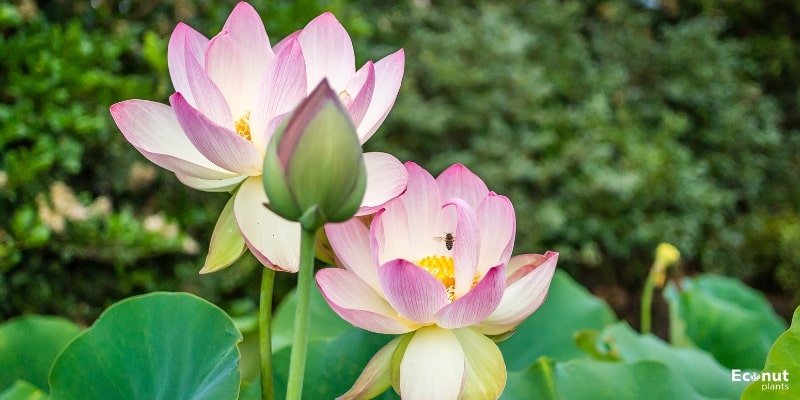 Botanical Name: Nelumbo nucifera
Botanical Name: Nelumbo nucifera
Sun Exposure: Full Sun
Hardiness Zone: 3-11
The sacred lotus is a magnificent example of a water sweller with significant blooming power. It’s a gorgeous plant, on top of all its fascinating cultural value.
Due to their aquatic nature, lotus plants—of which the sacred lotus is a kind—behave as perennials in colder areas, withering down yet growing again in the spring.
Rhizomes can freeze solidly without going extinct. The flowers have the most exquisite pink hue and are enormous (8″–12″). Because of their waxy coating, the leaves and flowers may flourish in the water.
14. Phalaenopsis Orchid
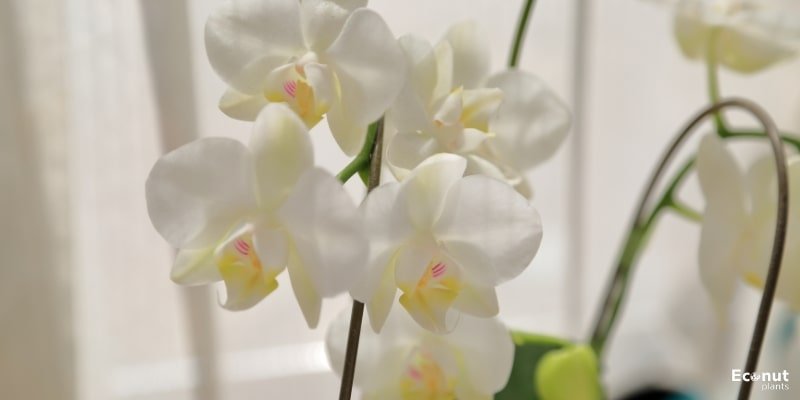 Botanical Name: Phalaenopsis
Botanical Name: Phalaenopsis
Sun Exposure: Full Sun to Partial shade
Hardiness Zone: 10-12
The most prevalent kind of orchids that are usually available for purchase locally in most places are phalaenopsis orchids, also referred to as moth orchids. There’s a solid reason why you frequently encounter these plants at big-box and supermarket retailers. As indoor plants, these are the simplest orchids to maintain.
In addition to being incredibly gorgeous, its moth-like, pendulous blossoms are also remarkably robust and persistent. Flowering Phalaenopsis plants can endure for up to two months. Due to their epiphytic nature, orchids require high humidity and a lot of air circulation around their roots.
15. Pink Maiden
 Botanical Name: Medinilla magnifica
Botanical Name: Medinilla magnifica
Sun Exposure: Full Sun to Partial shade
Hardiness Zone: 10-11
The long-flowering tropical plant known as pink maiden, or Medinilla magnifica, is indigenous to Southern Asia, Africa, Madagascar, and the Pacific Islands. The gorgeous, big, leathery leaves of this plant have bright green veining that contrasts with a deep, glossy green colour. This plant’s most notable feature is its amazing bloom production throughout a long flowering season.
If given the right care, the huge, pink, pendulous flowers can bloom from spring through autumn. Pink Maiden requires high humidity and warm temps. Since most Medinilla plants are epiphytes, it’s crucial to prevent overwatering this lovely tropical plant.
16. Porterweed
 Botanical Name: Stachytarpheta
Botanical Name: Stachytarpheta
Sun Exposure: Full Sun to Partial shade
Hardiness Zone: 9-12
Hummingbirds in the tropical garden are drawn to Porterweed, especially blue Porterweed. Porterweed grows extremely quickly and can grow up to 5 feet tall in a single growing season, even when grown as a deciduous perennial.
The plant is graceful and has delicate, beautiful flowers, but it is not as showy as some other tropical blooming plants.
Tall, slender inflorescences are supported by long stems that bear leaves shaped like those of plants in the mint family. The tiny, vivid purple-blue blossoms are tiny. Hummingbirds are most likely to visit this area of my garden, and bumblebees also appear to prefer it.
17. Blood Lily
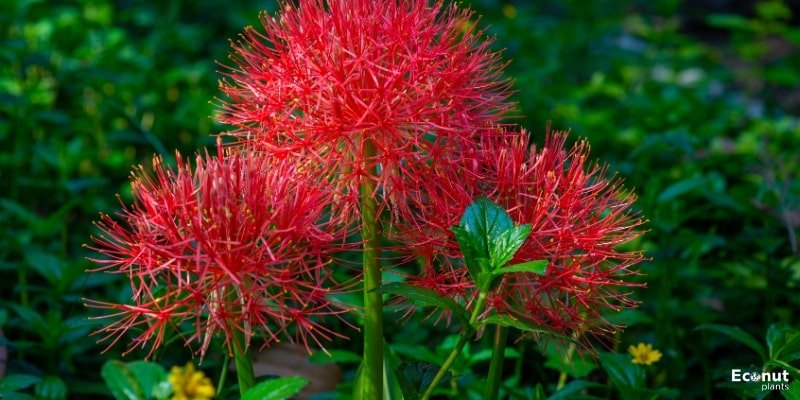 Botanical Name: Heamanthus multiflorus
Botanical Name: Heamanthus multiflorus
Sun Exposure: Full Sun to Partial shade
Hardiness Zone: 9-11
Fun and wonderful tropical plants, blood lilies are perfect as midground plants and require little maintenance. Though it will tolerate some partial shade as long as it is partially shielded from the afternoon sun, the plant prefers filtered or indirect light.
The blooms are reminiscent of fireball lilies, which are another name for them. Large, spherical, flaming red flower heads are present. Attractive to pollinating insects, the red, star-shaped florets have golden stamens.
18. Canna Lily
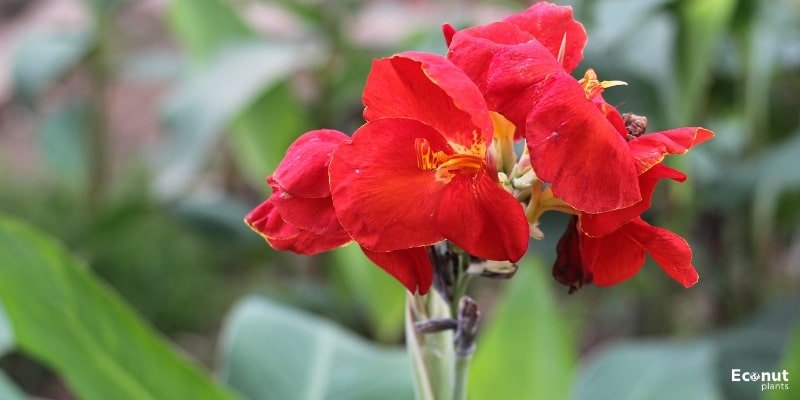 Botanical Name: Canna
Botanical Name: Canna
Sun Exposure: Full Sun
Hardiness Zone: 7-11
One of the plants that has an intensely tropical feel to it is the canna lily; however, it can withstand winters up to Zone 7. Dig up the rhizomes and preserve them for the winter in the garage or greenhouse if they are located north of Zone 7.
These plants grow in a manner that is quite similar to ginger plants. They are linked, and with time, they will clump together to form an amazing collection of these gorgeous plants.
Since cannas lack a bulb, they cannot be considered real lilies. In a single season, they usually grow to a height of 6 feet. These flowering plants are a wonderful focal point in the tropical garden because of their exotic flowers in the warm colour family and their gorgeous, frequently variegated, banana-like foliage.
Some species are native to the United States, although they are primarily from South and Central America.
19. Dendrobium Orchid
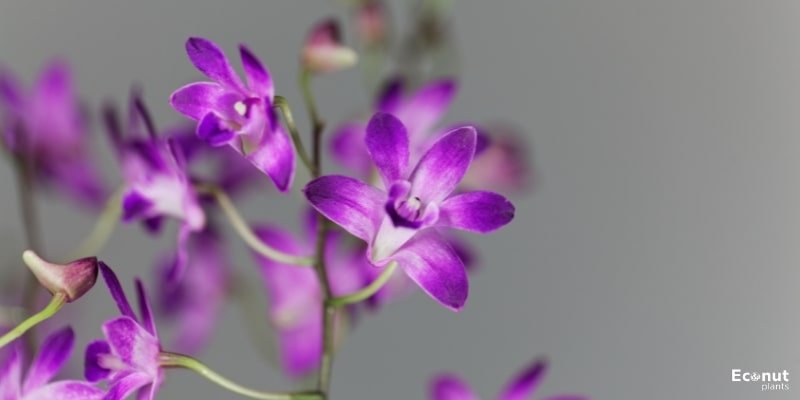 Botanical Name: Dendrobium
Botanical Name: Dendrobium
Sun Exposure: Full Sun to Partial Shade
Hardiness Zone: 9-12
Some of the most sought-after tropical plants are orchids, with collectors traveling vast distances to obtain the rarest and most intriguing specimens.
Because dendrobiums grow in trees or on rocks, they are either epiphytic or lithophytic. They require enough ventilation, drainage, and high humidity.
These plants will gladly grow in the shaded light of a tree canopy if they are tethered to the tree in a warmer area. These plants require a lot of light indoors, but direct sunlight may scorch the leaves; instead, bright, indirect lighting works best.
20. Gardenia
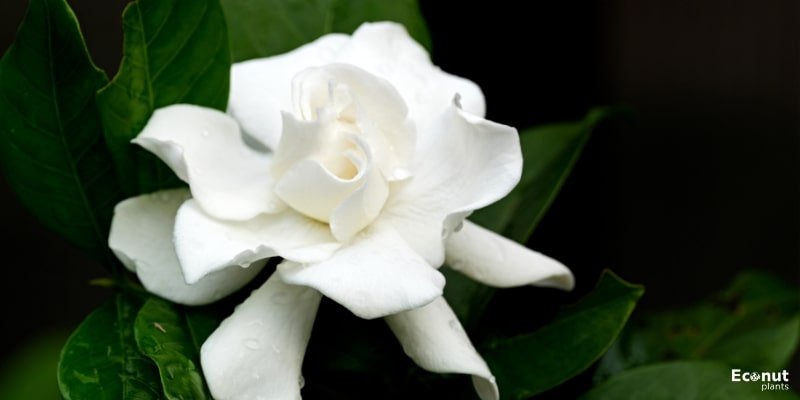 Botanical Name: Gardenia jasm inodes
Botanical Name: Gardenia jasm inodes
Sun Exposure: Full Sun to Partial Shade
Hardiness Zone: 6-11
The captivating fragrance of gardenias is well-known, and perfumers all over the world have imitated it hundreds of times. These exquisitely fragrant blooms are available for your garden if you reside in zones 6–11! Gardenia has a tropical vibe, even if it isn’t strictly a tropical plant.
Evergreen gardenias have a very high tolerance to cold. Though they may lose a few leaves after extended cold weather, most types can withstand lows as low as 15°F without losing any leaves.
21. King Protea
 Botanical Name: Protea cyaroides
Botanical Name: Protea cyaroides
Sun Exposure: Full Sun
Hardiness Zone: 9-12
King protea yields some of the most intriguing and sought-after flowers. Although it can bloom at any time of year, this native to South Africa usually does so in the warmer months. It grows naturally in coastal locations around the Cape of Good Hope.
Beautiful ovate leaves adorn tall brown stems that are well-anchored by deep, robust roots that provide wildfire protection. They prefer soil that drains well and has lots of sunlight.
When the plants reach their second year of life, they will start to produce beautiful flowers! The enormous (5″–12″) blooms are encircled by rose-pink bracts that mimic ray florets. Numerous little blooms in white and green tones can be found in the center.
22. Parrot Heliconia
![]() Botanical Name: Heliconia psittacorum
Botanical Name: Heliconia psittacorum
Sun Exposure: Full Sun to partial shade
Hardiness Zone: 10-11
Heliconia psittacorum, the bloom of the parrot, can make you think of another plant with an avian name. It has a lot in common with the bird of paradise.
Heliconia is a native of the Caribbean and South America, where she enjoys lots of sunlight, water, humidity, and rich soil. This evergreen is easily propagated because of its clumping habit and core rhizome.
Without the blue accents, the blooms resemble the bird of paradise quite a bit. The tiny flowers of Parrot Heliconia are encased and shielded by red and yellow bracts. These lovely tropical blossoms are a favourite feast for hummingbirds.
23. Pentas
 Botanical Name: Pentas lanceolata
Botanical Name: Pentas lanceolata
Sun Exposure: Full Sun
Hardiness Zone: 10-11
Pentas are a beautiful and effective technique to draw butterflies into your yard. Their ability to attract hummingbirds makes them a popular choice for pollinator gardens.
Native to Africa, pentas are seen from Yemen to East Africa. They are also referred to as the Egyptian Star cluster. Although it is usually grown as an annual elsewhere, it is only a perennial in zones 10 and 11. In colder climates, pentas will occasionally reappear after dying on the ground.
These are primarily recognized for their flowers, which bloom for a considerable amount of the spring and summer—and occasionally even into the fall—all covered in small, star-shaped blossoms. They usually reach a height of three feet and are available in red, pink, white, and purple hues.
24. Bush Lily
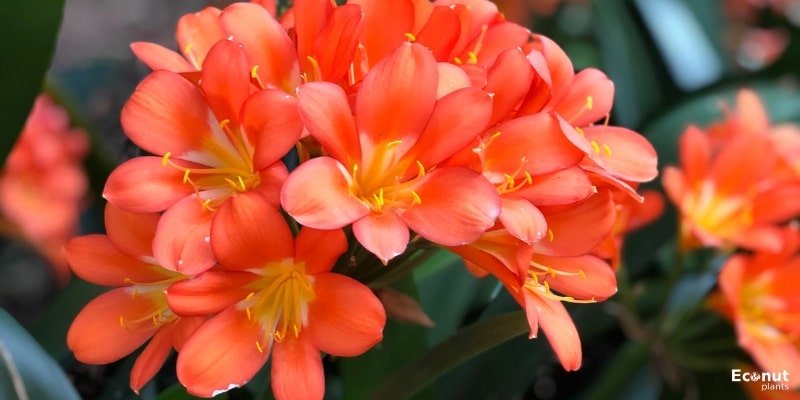 Botanical Name: Clivia
Botanical Name: Clivia
Sun Exposure: Full Sun to Partial Shade
Hardiness Zone: 9-11
Clivia is known by several names, such as cape lily and bush lily. They belong to the Amaryllis family and are endemic to South Africa. As such, they are bulbous and have a slight toxicity to animals.
These plants have beautiful, long, flat, strap-like leaves that are reminiscent of those of their ancestors. If you live in a colder area, bush lilies are great as container plants.
The bush lily likes bright windows indoors, but it does best outside in an area that receives afternoon shade. Since they are susceptible to root rot, pick a spot with adequate drainage as well. The most beautiful orange blossoms are produced by the bush lily in the summer. Hummingbirds and butterflies are drawn to their clusters of tubular blossoms.
25. Common Jasmine
 Botanical Name: Jasminum officinale
Botanical Name: Jasminum officinale
Sun Exposure: Full Sun to Partial Shade
Hardiness Zone: 7-10
Even though I only mentioned one variety of jasmine—the magnificent look and easy cultivation—this one is worth mentioning! Common jasmine is a beautiful vine that is either semi-evergreen or evergreen. It is not sensitive to the kind of soil or amount of sunshine as long as it receives a few hours of sunlight and proper drainage.
Together, the glossy, deep green foliage of the common jasmine plant is complemented by a cluster of creamy white blossoms that reach the stalks.
Excellent as a groundcover, climbing vine, or spreading shrub, the foliage also has a lovely aroma from the blossoms. Pruning will encourage more development and more abundant blooms on this gorgeous subtropical plant.
26. Flamingo Flower
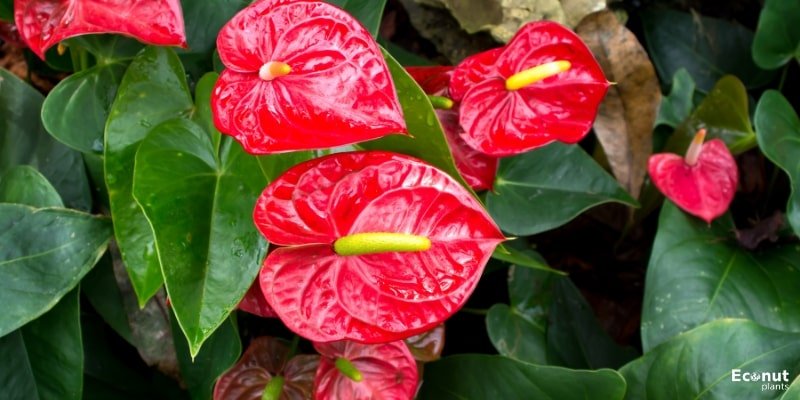 Botanical Name: Anthurium andraeanum
Botanical Name: Anthurium andraeanum
Sun Exposure: Full Sun to Partial Shade
Hardiness Zone: 10-12
This native of South America provides a brilliant splash of colour in a tropical landscape and is also a great houseplant. Anthurium is a plant found in rainforests that like damp conditions and indirect or filtered light. The common name “flamingo flower” comes from the fact that this species usually has pink blossoms, despite other species in the genus having a wide range of colours.
When given the correct conditions, Anthurium can bloom year-round and produce flowers that can last up to two months.
27. Frangipani
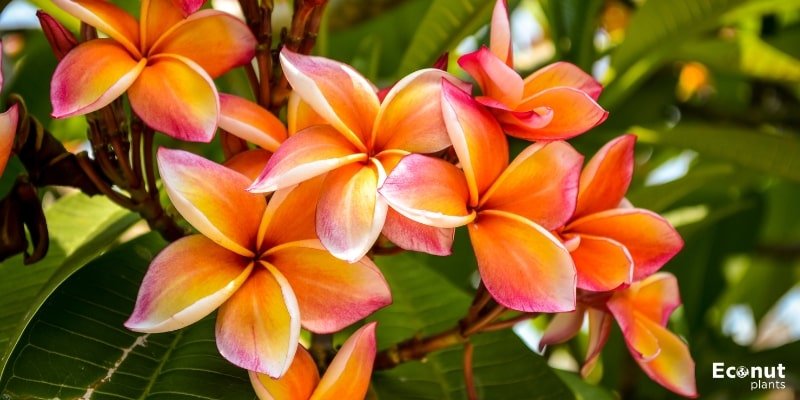 Botanical Name: Plumeria
Botanical Name: Plumeria
Sun Exposure: Full Sun to Partial Shade
Hardiness Zone: 9-11
The most popular application of frangipani, or plumeria, is as the flower used most frequently to construct Hawaiian leis. The smooth, grey bark of these huge shrubs or small trees contrasts with their interestingly leafless limbs. Large, elliptical leaf clusters at the end of each branch give the plant a tropical, palm-like appearance.
The tree develops its well-known flowers in the center of the leaf cluster. These lovely, whorling-shaped, five-petaled flowers are often bi- or even tri-coloured. Pink, purple, red, yellow, white, and orange are among the shades.
28. Moss Rose
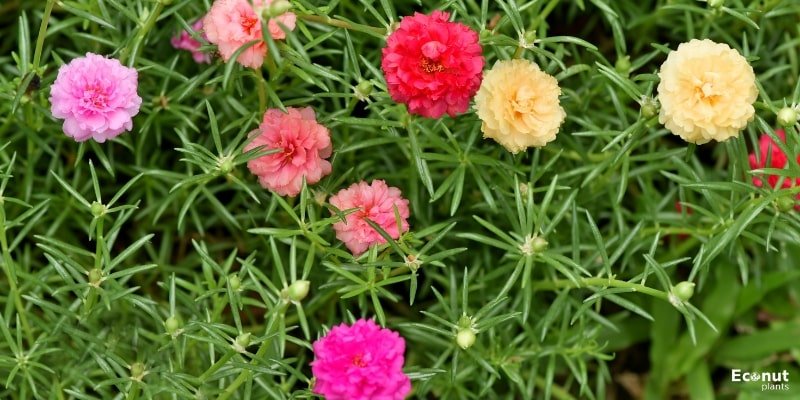 Botanical Name: Portulaca grandiflora
Botanical Name: Portulaca grandiflora
Sun Exposure: Full Sun
Hardiness Zone: 10-11
The Moss Rose is a beautiful hanging plant that also looks good as a ground cover. In tropical regions, this semi-succulent plant develops as an evergreen, but in colder climes, it is frequently grown as an annual. These little plants will fill in the spaces between stones in a rock wall quite nicely because they tend to crawl into cracks and crevices.
The moss rose is semi-succulent; therefore, don’t overwater it to prevent fungal root rot in the roots. The foliage has trailing stalks and is tiny, oval, and meaty. Variegated petal patterns of flowers bloom at the tips of stalks. These vividly coloured blossoms, which range from single to totally double flowers and even some specialty varieties, are stunning!
29. Amaryllis
 Botanical Name: Amaryllis
Botanical Name: Amaryllis
Sun Exposure: Full Sun to partial shade
Hardiness Zone: 8-12
The easiest way to identify this native of Central and South America is to look for it around the holidays in nurseries and retail establishments. Tropical bulb flowers like amaryllis usually bloom in the winter, but in colder locations, they can bloom into spring. They prefer bright early light combined with some shade later in the day.
The long, strap-like leaves of amaryllis grow at ground level. Each tall, fleshy, hollow stem holds a cluster of two to five blooms. Large and exquisite, the blossoms come in colours of pink, white, and red, with some bi-colour variants. Plant multiple bulbs close together for a truly outstanding cluster. The bulbs will put on a stunning display in late winter.
30. Bat Flower
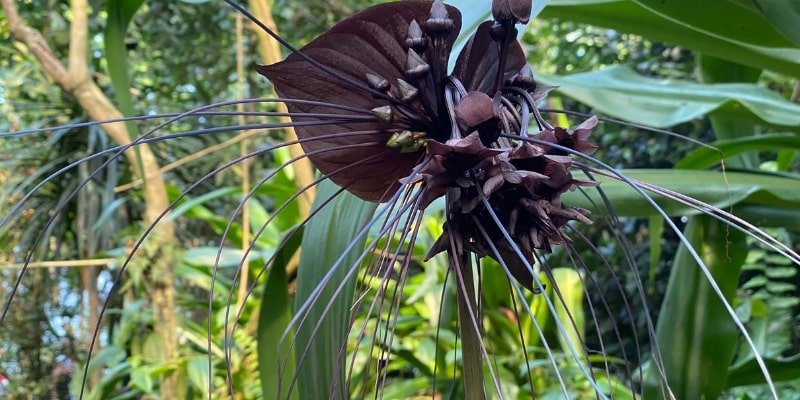 Botanical Name: Tacca chantrieri
Botanical Name: Tacca chantrieri
Sun Exposure: Full Sun to partial shade
Hardiness Zone: 9-11
The collector of exotic tropical plants will love this plant. Despite its tendency to be picky, it may be a superb discussion piece in the garden in the correct climate and setting.
Growing in the shade of trees in tropical woods, bat flowers are indigenous to Australia and Southeast Asia. The bat flower is like an orchid in terms of how it receives sunlight. It enjoys most of the day in filtered or dappled light.
Beautiful and strikingly tropical-looking foliage adorns bat flowers. From the base of the plant, large, oval, and glossy green leaves develop. Their name comes from their look, which is distinctly bat-like. The flowers grow atop tall stems.
31. Bird of Paradise
 Botanical Name: Strelitzia
Botanical Name: Strelitzia
Sun Exposure: Full Sun to partial shade
Hardiness Zone: 9-11
I’m not sure whether there’s a plant that looks more tropical than a bird of paradise. The palm-like and robust plant has a fan-shaped structure made up of leaves that resemble bananas. It grows up to 5 feet broad and in clusters, with some species becoming fairly tall. They are exceptionally drought-tolerant and prefer lots of direct sunlight.
Originating in South Africa, the plant known as the Bird of Paradise got its name from the unusual and avian-like way its blossoms appeared.
A fan-like flourish of bright orange and deep iridescent blue erupts from the tip of a tall, pointed bloom. Although they can bloom almost any time of year, the rarest period for birds of paradise to create their magnificent blossoms is in the autumn.
32. Arabian Jasmine
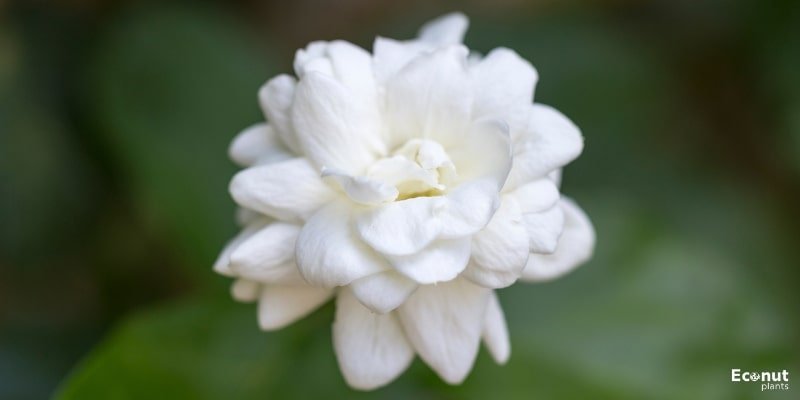 Botanical Name: Jasminum sambac
Botanical Name: Jasminum sambac
Sun Exposure: Full Sun to partial shade
Hardiness Zone: 9-11
There are so many varieties of jasmine that it is hard to select a single one to symbolize these fragrant, evergreen climbing bushes. The Arabian jasmine is undoubtedly the best variety in terms of scent, appearance, and flowering vigour.
You can cultivate Arabian jasmine as an espalier, a sprawling shrub, or a vine. It features ovate, glossy, smooth leaves and stems that tend to vine. Clusters of blooms emerge at the tips of branches, unfolding to reveal creamy white, completely double-petaled flowers. The blooms close in the heat of the day and open at night, filling the air with their potent scent.
33. Bromeliad
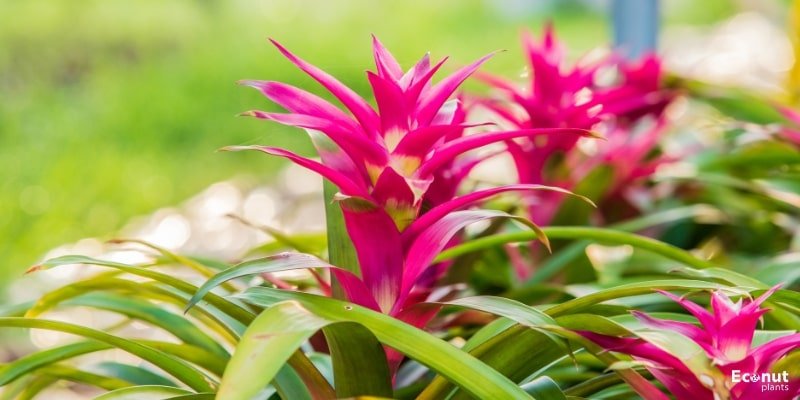 Botanical Name: Bromeliaceae
Botanical Name: Bromeliaceae
Sun Exposure: Full Sun to partial shade
Hardiness Zone: 9-10
These common epiphytic plants can be found growing on trees all over the Americas’ tropical regions. As a houseplant or garden plant, they can add an intriguing textural feature and are simple to grow and care for. These plants resemble their relatives, the pineapples, with shiny, stiff, pointed leaves arranged in spiral rosettes.
It is a bittersweet event because bromeliads don’t bloom until the very end of their lives, but don’t worry—they almost always reproduce before they pass away.
All but colour, the flowers are just like the leaves. While the blooms come in various hues of pink, red, yellow, purple, orange, and white, the foliage is green and occasionally variegated with white.
34. Cyclamen
 Botanical Name: Cyclamen persicum
Botanical Name: Cyclamen persicum
Sun Exposure: Full Sun to partial shade
Hardiness Zone: 9-11
Tropical gardens benefit greatly from cyclamen as foreground plants. To add a little bit of intriguing tropical foliage to the house, it also makes a fantastic houseplant.
Beautiful leaves adorn this endemic to the Mediterranean region. With a blend of pale and deep green patterns, the heart-shaped leaves grow in a dense mound.
On fragile stalks, cyclamen blooms climb above the canopy of foliage. These upward-facing, somewhat twisted petals have an upward orientation. They are available in pink, white, red, purple, and bicolour. It prefers well-draining soil and dislikes wet feet.
35. Angel’s Trumpet
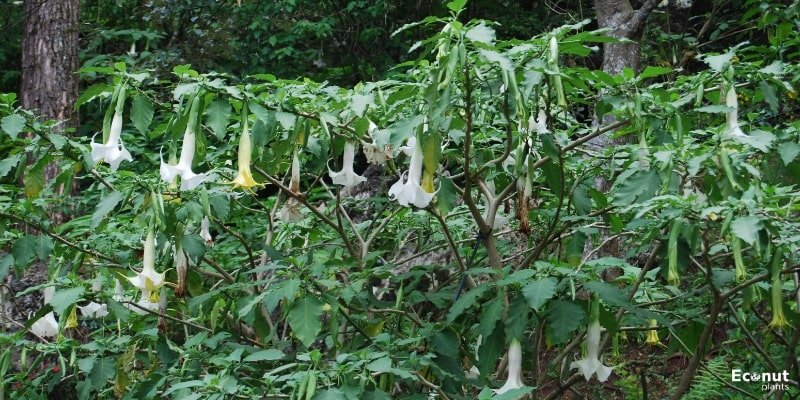 Botanical Name: Brugmansia
Botanical Name: Brugmansia
Sun Exposure: Full Sun
Hardiness Zone: 9-11
This stunning tropical plant adds a lot of drama to the garden setting. Angel’s trumpet can grow to be a large tropical tree or shrub, depending on the kind and amount of room it has. I would characterize this nightshade family member as being large and showy. Indeed, this indicates that these plants are toxic, so be cautious around this lovely plant if you have small children or pets.
The blossoms are incredibly aromatic and positively stunning. They are big, pendulous, pink, yellow, and white trumpets that hang downward. The foliage is vivid green and thick.
Conclusion
There’s something about tropical plants that makes every day in the garden seem like a trip. A tropical oasis may be created in any setting by combining several of these flowering plants, whether you’re filling a garden or creating a collection of tropical houseplants.

